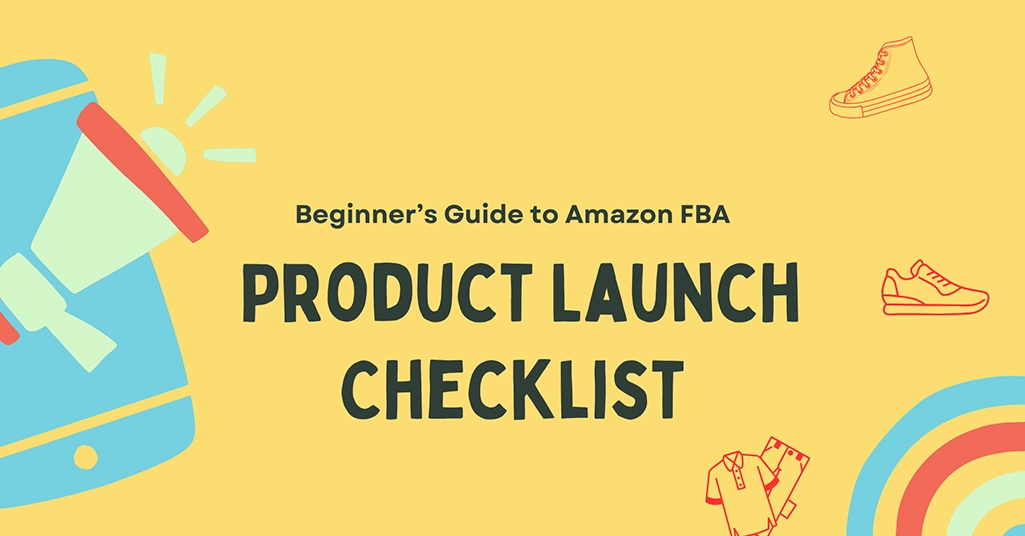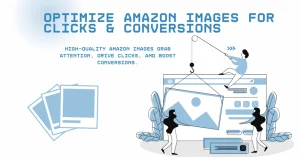Launch Your First Product with Amazon FBA Beginner Checklist
 Your experience of being an Amazon FBA seller can be like a roller coaster ride, but there is much to get to know as well. Choosing the right product, managing the inventory, handling everything, every step counts in case you want to expand your store in the right direction. There are a lot of sellers who try it without a clear-cut process and this usually brings about a lot of errors that could have been averted. This is where a perfect Amazon FBA checklist may become a game changer. It helps you follow a proven path that keeps you focused on what works. This blog brings you a complete guide that covers every key step from product research and supplier sourcing to account setup and launch strategy. Whether you are just getting started or planning your first shipment, this checklist is built to help you move forward with clarity and confidence in the Amazon marketplace.
Your experience of being an Amazon FBA seller can be like a roller coaster ride, but there is much to get to know as well. Choosing the right product, managing the inventory, handling everything, every step counts in case you want to expand your store in the right direction. There are a lot of sellers who try it without a clear-cut process and this usually brings about a lot of errors that could have been averted. This is where a perfect Amazon FBA checklist may become a game changer. It helps you follow a proven path that keeps you focused on what works. This blog brings you a complete guide that covers every key step from product research and supplier sourcing to account setup and launch strategy. Whether you are just getting started or planning your first shipment, this checklist is built to help you move forward with clarity and confidence in the Amazon marketplace.Amazon Product Launch Checklist for Smart New FBA Sellers
Starting strong with the right product is the backbone of any successful Amazon FBA business Here’s how you can make smart decisions that lead to long-term growth.1. How to Identify High-Demand, Low-Competition Products
The best products are not always the ones that sell the most. A winning product is one that has steady demand but not too many strong sellers offering it. Look for items that solve a simple problem, are easy to ship, and fall within a good price range. Products priced between twenty to fifty dollars often perform well because they are affordable yet still leave room for profit.A good sign of demand is if the product gets at least three hundred sales per month. To check the level of competition, see how many top listings have under five hundred reviews. Fewer reviews mean easier entry. This balance between high demand and low competition makes it easier to gain traction as a new seller.
2. What Data to Focus On
You should never guess which product to choose. Use real numbers to guide you. The four key data points to check are:- Monthly sales volume – shows how often the item sells. Go for products with at least three hundred sales a month.
- Review count – fewer reviews mean less competition. Avoid niches where the top listings have thousands of reviews.
- Pricing trends – check if the price holds steady or changes too often. Stable prices help keep your margins in control.
- Sales history – see if the product sells well across different months, not just during holidays or events.
3. Realistic Profit Margin Calculations
Before placing any order, work out your true profit margin. Many sellers only check the selling price and product cost, but that leaves out several key expenses. Make sure to include:- Amazon FBA fees
- Referral fees
- Shipping charges
- Customs or import duty
- Advertising costs
4. Red Flags to Avoid
Some products may look promising but carry hidden risks. Avoid the following traps:- Seasonal products – If an item only sells during holidays or one time of year, it could leave you with unsold stock later.
- Legal or restricted products – Some items need special permissions or documents. Always check Amazon’s list of restricted categories and local import laws.
- Saturated niches – If all top listings have thousands of reviews and are backed by big brands, the market may already be too crowded.
- Breakable or oversized items – These increase shipping costs and risk higher return rates.
Supplier Sourcing and Sample Testing Selecting the appropriate supplier is as crucial as selecting the appropriate product. A quality supplier makes your product well, delivers it to the customer in time, and meets customer expectations. This step builds the base for a smooth and successful Amazon FBA business.
1. Sourcing Channels: Alibaba, IndiaMart, Direct ManufacturersWhen you are ready to source your product, you have three main options:
- Alibaba – A global platform with thousands of suppliers for nearly every product. It is great for sourcing from China, but always check seller ratings and trade history before contacting.
- IndiaMart – A good option if you prefer sourcing from Indian manufacturers. Products such as textiles, leather products, and handicrafts tend to offer better pricing and local sourcing advantages.
- Direct manufacturers – If you prefer to own in the long term, invest in contact with manufacturers directly through trade shows, factory visits, or recommendations. This is more stable but involves more effort in the beginning.
Start by shortlisting at least five suppliers. Then compare them based on their communication, pricing, and readiness to work with small businesses.
2. How to Request a Sample and What to Inspect
Never place a bulk order without testing a sample first. A product sample gives you a real feel of the quality, finish, and packaging. Here’s how to go about it:- Request a double or single sample of your identical product with any personalization that you intend to have.
- Pay for expedited shipping, so you receive it within a few days rather than weeks.
- Upon receiving the sample, inspect the material's quality, weight, finish, and any moving parts if there are any.
- Also test the packaging- Make sure it protects the item during shipping and looks good enough for online retail. Keep notes on anything that needs improvement before you confirm the full order.
3. Checklist: Quality Control, Packaging, MOQ, Lead Times
Below is a basic check list to follow when discussing with selected suppliers:- Quality control- Learn what arrangements they make to ensure quality as well as how they determine quality. Others conduct in-house inspection but some outsource to the third party inspectors.
- Packaging capacity: Do they have ready packaging or only cartons in bulk. FBA asks for barcode labels and wrapping that is not easy to open, therefore, make sure to check about this in advance.
- Minimum order quantity (MOQ) A lot of suppliers have a MOQ but most of them are fair-minded when you politely request them. Start with a small order to reduce risk.
- Lead times- It is always good to enquire about the time lag between payment and shipping. The standard time should take less than 30 days. Add more time if you plan to customize.
4. Negotiating tips
These are some that never go wrong while negotiating with suppliers:- Be direct, simple, and polite in communication. Good communication leads to trust.
- Ask for cost breakdowns — product, packaging, shipping, so that you understand what you are paying for.
- If you can, inform them that you'll be sending additional orders if the initial one is successful. Repeat business can negotiate lower prices from most vendors.
- If they will not give a price reduction, request freebies such as barcoding, special packing, or faster manufacturing time.
5. Product Listing Optimization
Create a listing that helps you get found and convinces shoppers to buy.Crafting a strong listing:- Write a clear and keyword-rich product title
- Use bullet points to explain product benefits and key features
- Add backend keywords that match buyer search terms but do not repeat your title
- Amazon uses A9 to rank your product based on keywords, conversions, and sales
- Good listings with natural keywords and strong performance get indexed faster
- Upload high-quality images from different angles
- Add lifestyle photos to show the product in real use
- Include a video if possible to explain features clearly
- Use A plus content to build trust with better visuals and extra information
6. FBA Prep and Product Compliance
Make sure your product is ready for Amazon warehouses and follows all rules.Barcode and labeling:- Use a FNSKU barcode for private label products
- Place the barcode clearly on the outer packaging
- Avoid using the same barcode on multiple product types
- Choose packaging that protects the item during transport
- Match the exact dimensions and weight shown in your listing
- For bundles, seal all items as one single unit
- Check if your product needs approval in any Amazon category
- Prepare documents for items that require FDA, CE, or other safety marks
- Do not list restricted or unsafe items without clearance
7. Shipping to Amazon FBA Warehouse
Getting your products safely into Amazon’s warehouse is a key part of the FBA process. Follow the right steps to avoid delays or extra charges.Direct to FBA vs. Using a 3PL- Direct to FBA: Ship products straight from your supplier to Amazon. This saves time and cost but only works if your supplier knows Amazon’s FBA prep and labeling rules.
- Using a 3PL (Third Party Logistics provider): Ideal if your supplier cannot follow FBA prep. A 3PL will inspect, label, and repackage products before sending them to Amazon. This gives more control and helps catch issues early.
- Log in to your Seller Central account
- Go to the Manage Inventory section
- Select your product and click on Send to Amazon
- Fill out shipment details: quantity, box size, weight, prep and labeling options
- Confirm the warehouse Amazon assigns and generate shipping labels
- Double-check box dimensions and weight to avoid overcharge
- Add a clear box content list if you pack multiple SKUs in one shipment
- Print and stick the FBA box labels provided by Amazon
- Schedule pickup with your chosen carrier, like UPS or FedEx
8. Launch Strategy Checklist
Your launch sets the tone for your product’s future. Focus on visibility, early sales, and strong customer feedback.Building Early Momentum- Run Amazon PPC ads from day one to get traffic
- Use coupons or discounts to boost initial orders
- Set a competitive price and increase slowly as reviews and rank improve
- Monitor clicks and conversions to adjust ad spend early
- Use Amazon’s Request a Review button inside your orders tab
- Send polite follow-up messages through Buyer-Seller Messaging
- Avoid offering rewards or asking for positive reviews — this breaks Amazon’s rules
- Encourage natural feedback by offering good product quality and clear instructions
- Sales velocity: Aim to sell at least 5 to 10 units per day
- Conversion rate: Track how many clicks turn into sales
- Review count: Try to get your first 5 reviews within 2 to 3 weeks
- Organic rank: Check where your product shows up for main keywords
9. Performance Monitoring and KPIs
Once your product is live, regular tracking helps you grow and avoid losses. Monitor your numbers daily and act fast when needed. Key Metrics to Track- Sales performance: Daily revenue, units sold, and profit margin
- Advertising Cost of Sale (ACOS): Shows how much you spend per sale
- Return on Investment (ROI): Compare ad spend, product cost, and final profit
- Buy Box win rate: Track how often your product is the one Amazon shows for buying
- Check inventory levels to avoid stockouts
- Monitor ad performance and adjust bids or keywords as needed
- Track unit session percentage to measure conversion rate
- Check customer feedback and answer any open questions
- Ignoring low stock alerts or slow sellers
- Letting ads run without checking results
- Failing to respond to customer reviews or messages
- Not checking your keyword rank drop after a listing update



Step-by-Step Amazon FBA Startup Guide for First-Time Sellers
Launch Your First Product with Amazon FBA Beginner Checklist Your experience of being an Amazon...
Share this link via
Or copy link